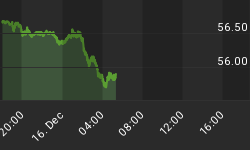There will be many more days ahead for the Fed, and many of them will have plenty of good news. It is a mistake to trya and read too much into one day's economic releases. With that said, here is my attempt to do exactly that.
I tweeted the following real-time reactions (@inflation_guy) following the CPI release this morning:
- Ready for an exciting day...CPI, Claims, Philly Fed, a 30-year TIPS auction, wild commodity swings, 3 Fed Presidents...buckle up!
- Hello! Core inflation +0.3%, higher-than-expected. Look out above.
- Apparel +0.8%. Some will pooh-pooh the number on that basis, but Apparel has been trending higher for more than a year.
- To be fair, core inflation BARELY rounded up to +0.3%. But the market was looking for +0.16% or +0.17%.
- Core Services remains at +2.5% y/y, but core goods ticks up to +0.4%. The recovery of core goods has been something we're looking for.
- Somewhat surprisingly, the +0.251% rise in core inflation did so without having a rise in Owners' Equiv Rent. Went from 2.1% y/y to 2.08%
- Accel Inflation: Housing, Apparel, Educ/Commun, Other (54.7% of basket); Decel: Food/Bev, Transp, Med Care, Rec (45.3% of basket)
- In Transp, the drag was almost all fuel. New/used Cars, maintenance, insurance, airline fares, inter- and intracity transp all up.
- What's amazing in the CPI today is how much it did with how little from the main driver of housing. That uptick is yet to come.
- ...and, next month, headline will get upward pressure from the steep rise in gasoline, which also dampens discretionary spending.
The primary takeaway from the CPI release is this: yes, core inflation surprised a little bit on the high side. But it did so without the support of the main factor that I think will push core inflation almost certainly higher going forward: housing. Rents (both primary and OER) neither accelerated nor decelerated this month from the prior year-on-year pace. And yet, there is really no temporary factor that pushed inflation higher this month. It was fairly broad-based. Apparel stood out on the month-to-month change perspective, but here is the chart (source Bloomberg) on Apparel:

This month doesn't appear to me as too much of a true outlier. The underlying dynamic there has simply changed.
So this month core inflation stayed at 1.9%; next month it is very likely to return to 2.0% as we are dropping off the weak February change from last year. And all of that, before the housing inflation hits the data.
Speaking of housing inflation, there is no sign yet of that abating. In today's Existing Home Sales report, the year-on-year change in Median Existing Home Sales Prices rose to 12.61%, another post-2005 record, and the highest real price increase ever, outside of 2005. This is happening because the inventory of new homes has dropped to almost a record low - really! Sure, the chart below (source Bloomberg) ignores "shadow inventory," but it is starting to look more like the inventory of new homes now.

Some of that is seasonal, but there's no doubt that lower inventories are now helping the home pricing dynamic. And, as I've shown previously, the inventory of existing homes actually has a nice relationship with shelter inflation 1-2 years later (Source: Enduring Investments):

The current level of inventories translates into a 3.6% expected rise in CPI-Shelter over the course of 2014. So you see, we're not only firing inflationary rounds but we're also continuing to feed more ammunition into the gun for next year. Our model of housing inflation projects Owners' Equivalent Rent no lower than 3% by year-end 2013. And if that happens, there is no way that overall core inflation is going to be at 2%.
Now, in addition to the bad news on prices and the news on home prices that are probably seen at the Fed as a guarded positive (after all, it means the mortgage crisis is essentially over as more borrowers will be 'above water' again every month hereafter), there was also a mild surprise on the high side from Initial Claims (362k versus 355k) and a bad miss on the Philly Fed index for February. This latter was expected at +1.0 after -5.8 last month; instead it dropped to -12.5. Philadelphia-area manufacturers have reported softening business conditions in three of the last four months, suggesting that December's pop to +4.6 was the outlier. Now, there were similar one-month dips in August of 2011 and June of 2012, so we'll have to see if it is sustained...but it is consistent with the report out of Wal-Mart and the worsening of business conditions in Europe.
Higher prices (and more coming, on the headline side, as retail gasoline prices have now risen in 35 consecutive days) and lower business activity. This is exactly the opposite of what the Fed wants. It has been a bad day at the Fed.
However, it is exactly what traditional monetarism expects: accommodative monetary policy leads to higher prices (check), and has no effect on real activity in the absence of money illusion (check). So score one point for Friedman today.
And so, what else would you expect after such a day? Bond yields are declining, inflation breakevens are narrowing, and industrial commodities (metals and energy) are sliding. As with so much else these days, that makes no sense, unless you just don't know what's going on. When we encounter these bouts with irrationality (or, more fairly, thick-headedness), the market can be frustrating for a long time - and the ultimate denouement can sometimes be jarring. As I said earlier in this post: buckle up!
















